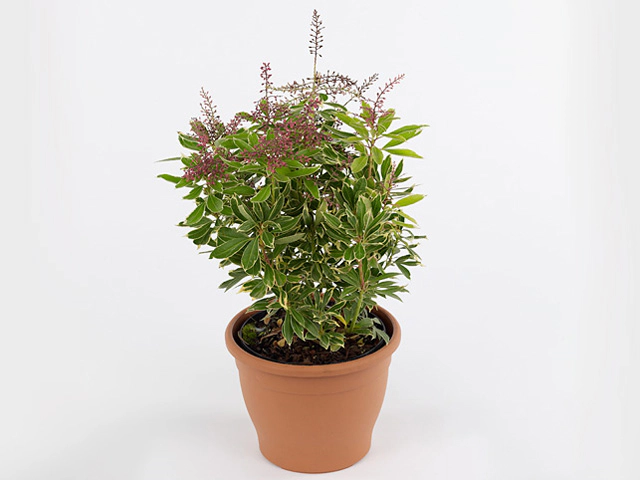Pieris japonica 'Ralto'

| Leaf arrangement | spreaded |
| Leaf tip | Mucronate |
| Leaf margin | Dentate |
| Winter hardness | Reasonable (USDA-zone 7) |
| Flower color | Red-medium red-047B |
| Leaf, general shape | Lanceolate |
| Plant height | 30 - 40 cm |
| Inflorescence | Raceme |
| Leaf duration | Evergreen |
| Leaf size | 5 - 7,5 cm |
| soil pH requirement | Slightly acidic (pH 4,5 - 6,5) |
| Light conditions | Sunny; Semi-shades |
| Leaf, main color | Dark green |
| Leaf colour, pattern | Marginate |
| Leaf, secondary color(s) | Cream |
| Toxicity (if consumed) | Fairly |
| Moisture requirements | Normal |
| Soil type | Sandy; Peaty |
Pieris japonica 'Ralto', commonly known as Lily of the Valley Bush, is a versatile and visually stunning plant that offers many desirable characteristics for garden enthusiasts. This article will delve into the various features of this plant and shed light on its growth requirements and overall beauty.
One of the standout qualities of Pieris japonica 'Ralto' is its leaf arrangement, which is spreaded and adds to the visual appeal of the plant. The leaves themselves have a lanceolate shape, with a mucronate tip and a dentate margin, giving them a unique and attractive appearance. The main color of the leaves is a deep and rich dark green, which creates an eye-catching contrast in any garden.
The Lily of the Valley Bush is a medium-sized plant, typically growing between 30 to 40 centimeters in height. Its evergreen nature ensures that it provides color and interest to the garden throughout the year. The leaves remain on the plant, offering a beautiful backdrop even during the winter months. Additionally, the moderate winter hardness of USDA-zone 7 ensures that this plant can withstand colder temperatures, adding to its versatility in various climates.
In terms of flowering, Pieris japonica 'Ralto' produces vibrant red-medium red blossoms in raceme inflorescences. These flowers are a true showstopper and can add a splash of color to any garden. They bloom during the appropriate season and can create a visually striking display.
To meet the plant's growth requirements, it is important to consider its preferred soil conditions. The Lily of the Valley Bush thrives in slightly acidic soil, with a pH range of 4.5 to 6.5. Sandy and peaty soil types are suitable for this plant, providing a medium that allows for proper drainage while retaining adequate moisture. Normal moisture levels are sufficient for this plant, eliminating the need for excessive watering.
Light conditions are another crucial factor to consider when growing Pieris japonica 'Ralto'. This plant prefers sunny or semi-shaded areas, where it can receive an appropriate amount of sunlight. Finding the right balance between sunlight and shade will ensure the plant's optimal growth and blooming.
It is worth mentioning that Pieris japonica 'Ralto' possesses some toxic properties if consumed. As such, it is important to be cautious around this plant, especially if there are children or pets in the vicinity. Educating oneself about the potential risks and taking necessary precautions is essential for a safe gardening experience.
In conclusion, Pieris japonica 'Ralto', or Lily of the Valley Bush, is a visually stunning plant that offers a plethora of desirable characteristics. Its lanceolate leaves, with their spreaded arrangement, add to its overall appeal. The plant's evergreen nature and beautiful red-medium red blossoms make it an excellent choice for adding color and interest to any garden. It thrives in slightly acidic soil and requires sunny or semi-shaded areas to grow optimally. While caution should be exercised due to its toxicity if consumed, the Lily of the Valley Bush can enhance the beauty of any garden with its unique and captivating features.
Market availability index by month:
| Jan. | Feb. | Mar. | Apr. | May | Jun. | Jul. | Aug. | Sep. | Oct. | Nov. | Dec. |
|---|---|---|---|---|---|---|---|---|---|---|---|
| 1 | 3 | 4 | 2 | - | - | 1 | 1 | 3 | 2 | 1 | 1 |